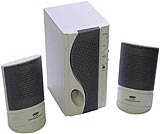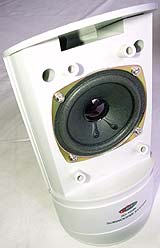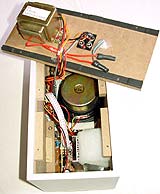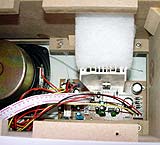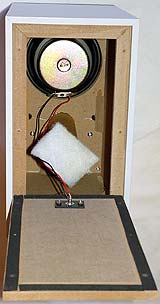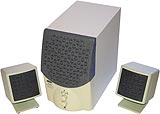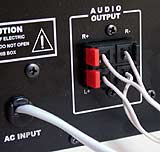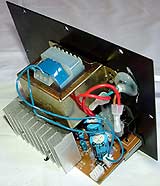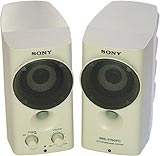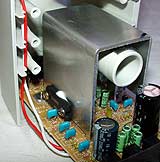
Juster three-piece speaker systems versus Sony SRS-Z750PC speakers
Review date: 25 January 2000. Last modified 03-Dec-2011.
It's surprising how many computers have kick-butt sound cards capable of studio quality output, yet use dinky little speakers to deliver that sound to the user. If all that ever comes through your speakers is the whimsical Windows system sounds of your choice, or if you're forever shifting your computer around and don't want to have to lug any more big boxes, then you've got an excuse. But if you actually want to enjoy the sound from games, music software or even DVD playback, you really need something better.
Let's assume you're on a budget, and don't want to buy some monster multipoint setup. Let's also assume that you don't have a spare hi-fi system whose auxiliary input you can hook up to your computer's line output - this is the cheapest way to get great bassy stereo sound, but if you don't actually have a spare stereo or the space to put one in the computer room, it's not an option. Stereo speakers are also, usually, not magnetically shielded, so they'll distort the image on your monitor if you put them close to it. Computer speakers, including all of the speakers in this comparison, have magnetically shielded drivers that won't muck up the image on any monitor (or TV, for that matter).
So, given these assumptions, you're after something that doesn't take up too much space or cost very much money, but sounds OK. You're not going to get concert hall realism out of any low cost computer speaker system, but that's all right; you just want something with a bit of bass and, perhaps, somewhat less obnoxious resonance problems than the average crummy plastic-boxed single-driver widerange speakers.
What you're looking for is a cheap three-piece system.
These systems have a couple of satellite speakers which are, by themselves, about as awful as the crummy speakers you're replacing. Fortunately, they also have a subwoofer. The sub plugs into the wall and contains amplifier hardware for itself and for the satellites. The sub also has some kind of "crossover" network to make sure the sub gets most of the bass frequencies and the sats get most of the midrange and treble. These crossovers are usually pretty rudimentary in cheap systems, so the teeny satellites still have to try to deal with bass and the sub driver, buried in its box, contributes a bit of distorted midrange as well. But they work fairly well.
A subwoofer is supposed to be something that emits the really low bass tones that most speakers can't get near, but the subs that come in cheap three-piece system stretch the definition a bit; they don't have much deep bass response, because they're quite small (think two to three stacked shoeboxes) and use drivers about five inches in diameter. You are just not going to get response below 50Hz out of a five inch driver, no matter how fancy a box you put it in, without doing Bose's trick and using an array of the things and a huge bass boost. But given that nasty little plastic speakers with three inch drivers (or smaller) invariably give up at least an octave higher, these little subs do very well for the money.
What kind of money? Glad you asked.
I've checked out no fewer than four three-piece systems from Juster, a popular maker of dirt cheap speakers whose products I've previously reviewed here. The speakers I reviewed last time have been superseded, now, so I decided to check out what Juster have to offer at the moment. All four systems sell for well under $200 Australian, and one of 'em's less than $AU100. All of them have plastic satellite speakers, but wood-boxed subs, which is pretty impressive for the money.
Just in case you want to see what the big end of town has to offer, I've also checked out Sony's SRS-Z750PC speakers, a conventional two-piece system with no sub which sells for $AU209. And which therefore looks somewhat less than exciting next to the cheaper and much heftier Juster systems.
When I mentioned to the nice Sony PR lady that I'd be comparing the speakers she'd sent me with a pile of cheap Taiwanese three-piece systems, she tried her best to hide her depression. I had a suspicion that Sony's rather expensive tiny desktop speakers might not fare too well against cheaper alternatives that came with a subwoofer as well, and it would appear she did, too.
On with the show!
Juster 3D-103N
At a mere $89 (Australian dollars - maybe $US60!), the 3D-103N's certainly cheap. It's a nice looking setup, too, with unusual cylindrical satellite speakers and curvy styling on the sub. The satellites plug into the sub with leads that terminate in ordinary RCA connectors, which can handle the current draw of small speakers. The leads are about 1.2 metres (4 feet) long. The sub also has RCA connections for input, and comes with a 1/8th inch stereo plug to twin RCA plug lead.
The grilles can easily be unclipped from the satellite speakers. This is unusual; most cheap speakers have grilles glued into or moulded as part of the box. Underneath there's a driver that could be called a three inch if you were generous or a two inch if you weren't. The port at the top of the speaker points upwards, which might create a wider sound dispersion pattern. The driver fires straight forwards.
To actually take the satellites apart you have to peel off the edges of the big felt circle they stand on, to get at the screw holes. Inside, there's not a skerrick of damping material.
The subwoofer packs a 15 watt four inch driver and a quantity of electronics (including the usual tiny amplifier IC with a big fat aluminium heatsink), in a nicely corner-braced enclosure - well, for the money, anyway.
There's a token block of fluffy wadding over the end of the port tube, which will reduce whistles from air going into and out of the port, but won't really make a lot of difference to anything.
Some very expensive speakers use boxes based on the cylindrical idea, but making little plastic speakers cylindrical is, like putting a whale-tail spoiler on a Volkswagen Beetle, not actually going to do anything worthwhile to their performance. Listening to the 103N system confirms this; the satellites sound small and plasticky, but they're helped enormously by the sub.
All of the Juster systems have a "bass" knob as well as the volume control, and in all cases if you turn the bass up all the way you get more of it than you should have. At the max-bass setting, the sub will actually be overdriven and start producing rather nasty distortion at pretty low volume levels. More sensible settings, though, let you get a tolerably flat response out of the system, or wind the bass up to suit your taste in games or for... appropriate... music.
For an $89 system, the 3D-103N sounds brilliant. The little satellites aren't as bad as they could be, and the sub can get the floor moving a bit, and it's all nice and small and easy to deal with. But what if you want a bit more?
Juster 3D-128N
Enter the 128N system. Selling for $AU129, it's got the biggest sub of all the systems I review here, and it's also got an unusual design - the amplifier hardware and computer connections are mounted on the left satellite speaker, leaving the sub as an ordinary box. The left satellite has the RCA connectors and the controls on it. And yes, sharp-eyed readers will note that for the photo shoot I put the darn satellites on the wrong sides of the subwoofer. I apologise for any confusion caused.
The unusual connection setup for the 128N means that even though it's got 1.8 metre (6 foot) cables for both the sub and the right satellite, you probably won't be able to put the speakers as far apart as you can with a central-sub design. The cables as they stand should span most desks with no trouble, though, and it'd be easy enough to extend them.
There's also a four-satellite version of the 128N, which sells for $AU195. This is not a true surround system; the back-left and back-right speakers just get the same signal as the left and right satellites. So if you've got a sound card with true four speaker output (like the Turtle Beach cards I review here), this is not what you want. It's a decent way to get enveloping sound on the cheap, though.
Inside the 128N sub is nothing but the five inch driver and the port, which is capped with another puff of acetate fibre. Again, the box has a few joint braces, and it's actually very well sealed - the back panel has the same foam strips on it as the panels on the other Juster subs, but it's a very tight fit. It's not as good as the proper sealed panels on "real" speakers, but for a weeny low-cost sub it's a very well made thing.
Inside the 128N's "power satellite" there's another crammed-together electronics bundle, and a couple of surprises. One, there are dual ports - the regular tubular one at the front (adorned, again, with an acetate fibre square), and a simple grille-covered hole at the back. Maybe this is a piece of fiendishly clever tuning, but I think it's just an attempt to keep the amplifier a bit cooler, and make the speaker a bit louder at the same time, at the expense of a bit of bass.
The 128N satellites also have, shock horror, two drivers - there's a little one inch tweeter as well as the two-to-three-inch main driver. The tweeter has the simplest of all crossovers - an in-line capacitor.
The wiring inside the 128N power sat is plentiful and loose enough that I wouldn't be surprised if it could buzz against the casing when the volume was turned up. I didn't notice any such noises when I did the listening test, though.

I love Taiwanese products. This, from the back of the 128N subwoofer, is the most unnerving rendering of the "Double Insulated" symbol I've ever seen. The symbol is supposed to have two concentric squares. I don't think it'd take the electricity too long to get out of that spiral!
I also didn't notice any particular improvement in the sound from the 128N twin-driver satellites versus the single-driver units used by the other systems in this comparison. Maybe they were better. They still weren't terribly good. But hey, what do you want, for the money. The 128N sub is less over-the-top in its tuning than the 103N's, or maybe the 128N's bass boost just doesn't go as far; in either case, there was noticeably less bass for a given bass boost setting. This is no bad thing, given that the other Juster systems really offer far too much bass boost at their maximum settings. The bigger box volume (from the physically larger box, and from the fact that the box isn't full of electronics) gives the 103N's sub deeper overall bass response, and better music performance.
If you want maximum boom, though, you'll be wanting a more sophisticated sub design, to really put a hump the size of a hippo in that response curve.
Juster 3D-601 and 3D-803
Enter the newest members of the Juster range, the 601 and 803. They're cheapies too, with an recommended retail prices of $AU75 and $AU99.
Both of these systems have "bandpass" subwoofers. Bandpass boxes have a subdivided enclosure, with a panel down the middle that the driver mounts on. On one side of the panel the box is sealed; on the other side there's a port. A good bandpass box can give excellent bass response without a monster hump in the response curve.
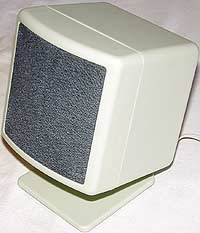
The 601 and 803 both use the same satellite speakers, little cubic things plastic-welded together. These sats have built in stands that point them slightly upwards, so you can aim them towards your ears more easily.
They connect to the subwoofer via conventional bare-wire speaker cables, which you plug into plastic clip terminals.
Phase problems
The Juster spring terminals are quite well made and let you easily swap the satellites for something better if you like, but they also make it possible to wire the satellites out of phase.
Speakers that are in phase all move their cones in the same direction, creating a pressure wave, at once when they're all fed the same signal. Wire them out of phase - getting one of 'em backwards, in essence - and the out of phase speaker's cone will move the other way, creating odd interference effects and doing violence to your bass response and stereo imaging.
Out of phase wiring can actually be useful in some circumstances - for sound reinforcement installations or tricky surround sound work, for instance, when a speaker is far enough away that its sound takes longer to get to the listener, or where you're trying to create that illusion. But for normal installations, and certainly for stereo pairs, it's to be avoided.
With a sub-sat system, you can get it wrong both by wiring the satellites out of phase to each other, or by wiring the satellites in phase with each other but out of phase with the sub. The first situation will give clearly wrong sound, and it's easy enough to avoid - just make sure that the (rather faintly) striped wire from each satellite goes to the same terminal on that satellite's connector on the back of the sub.
The second error will be a lot harder to pick, but you should avoid it anyway; remember, by convention, the striped wire is negative. Negative can also be indicated with a ridge on the wire insulation, or by tinning the conductors for that lead (so the wire looks silver, not copper-coloured).
Usually.
No, I don't want to hear about your English, American, Yugoslavian or Spanish hi-fi or automobile that does it the other way.
If a speaker has a black wire and a coloured wire, the black wire is negative.
Always.
La la la. I can't hear you.
You can tell, incidentally, which way around a speaker is wired (some come from the factory wired backwards...) if you can simply put a finger (gently) on the speaker cone, and have an ordinary battery handy. Hold one speaker wire against one end of the battery and tap the other wire against the other end; if the speaker cone pops outwards, you've got the battery negative terminal on the negative wire and the positive terminal on the positive wire. If it pops inwards, you've got it the other way around. Don't leave the speaker connected to the battery, or you might overheat the voice coil.
This test isn't possible with the sealed-tight 601 and 803 satellites, though, so you've just got to have faith that the striped wire is negative.
The 601 and 801 use the same electronics module, and each have two inputs. Each input is a 1/8th inch stereo jack. Only one cable is included, but 1/8th inch to whatever-you-like cables and adaptors are easy enough to get. The dual inputs make it easy to connect the speaker system up to both your computer and a stand-alone CD player or tuner or whatever.
The 601, as the smaller and cheaper system, has no headphone jack (all of the other Juster speaker systems do). Its sub is a bit smaller than the 803's.
Inside the 803 subwoofer you can see the backward-firing 5 inch driver - maybe a bit bigger, if you're generous - and the port that feeds through the sealed front compartment to the grille-covered front panel. The 601 has the same arrangement, but smaller.
There's barely any slack in the 601/803 internal wiring, which is a good thing. Loose wires, especially in a subwoofer, can buzz when you turn the volume up. This does make it a bit awkward to disassemble, though; you have to unplug five connectors in order to remove the back panel with the amplifier assembly on it.
There's a dire warning not to remove the back panel printed on it. It has a point, because it'd be quite easy to tear the foam seal around the panel hole with all the sharp edges of the panel, the transformer, and the amp chip heatsink, while you were wrestling with the wires.
Listening to the 601 and 803 systems didn't reveal any stunning improvements from the bandpass subs. Then again, it didn't show up any terrible problems, either.
Like all tuned enclosures, a bandpass box has to be tightly matched to the specifications of the driver that goes into it. Many cheap speakers have drivers with characteristics that vary from driver to driver; manufacturers also, commonly, change horses mid-stream and switch to a completely different driver without changing the box. Even if they did a careful job designing the box in the first place, this can screw up the output noticeably. I'm happy to say, though, that the 601 and 803 don't have any weird honks or rumbles that would indicate a badly mismatched driver. Neither did they sound markedly better than the plain ported boxes of the older Juster subs, though. Again, the bass boost could go up further than you'd probably want to turn it, but at moderate settings the sound was quite balanced.
The tiny 601/803 satellites sounded much the same as their larger, older cousins, which was a relief. Maybe the midrange was a bit strangled, but you really couldn't pick it easily. With the simple spring terminal connections, it'd be easy to connect better satellites to the 601 or 803; if you've got a couple of boom-box speakers with the right wiring on them handy, I'd try 'em out. Remember, though, that speakers not designed for use near screens are seldom if ever magnetically shielded, so you'd want to put them a couple of feet at least from your monitor.
Sony SRS-Z750PC
And on to the losers. Sorry, but it's true; when you pay more and get less, what else can you say?
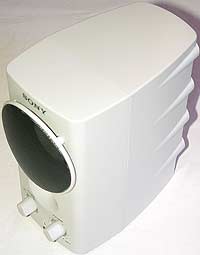
The styling of the little Sonys is rather nice, with a swoopy tail and stand-off mounted circular grilles. The box they came in showed a set in metallic silver plastic, but what came out of that box was just plain beige, like all the Juster speakers. If the Z750s had been the shiny version, or translucent iMac imitators, or something, they would have scored better. But they weren't.
The construction quality of the Sony speakers is better than that of the Juster satellites; they've got proper sealing and even a rectangle of cotton waste on the back of the cabinet for damping. As you'd expect, for the money.
The Sony amplifier chip has a big, well-braced arch heatsink, and the circuit board is clearly better made. There's no big power transformer inside the case; the Z750s run from a plugpack supply.
The business end of the Z750s, though, are the drivers. And they're barely bigger than two inches in diameter. It's all that'll fit; these are quite small speakers.
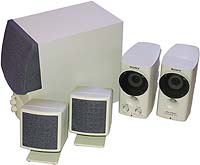
Sony Z750s, right, compared with the Juster 3D-803.
I was pleasantly surprised by the bass response from the Z750s. There actually was some. There wasn't bloomin' much, though. The Sonys have just a rotary power switch and a volume control; there's no bass boost. Those little drivers couldn't handle much, anyway.
It's an unavoidable fact; you can only get so much bass out of a weeny little driver. You canna change the laws o' physics. And when you're Sony, with a giant world-wide marketing campaign to support, you just can't sell low-tech products like basic computer speakers at prices to match cheap and cheerful South-East Asian budget manufacturers like Juster.
Overall
If you want a portable CD player which requires precision measurement to determine whether it is, in fact, any bigger than the CD you put in it, Sony are up there with the world's best. And they can make great monitors (I review one here), and video projectors, and other things that need cutting-edge tech. But there's only so much that can actually be done with simple little speakers, so all Sony can do to compete is make really stylish looking boxes and hope their brand name makes the sale for them.
If you want a decent pair of small speakers then the Sonys are just fine, but you can get speakers that sound no worse for a lot less.
Of the Juster systems, the 128N system is probably the best. The 128N will do the best job of music. The 601 and 803 are pleasingly cheap, though, and would both make a nice noise for game players.
There's really not a lot between the Juster systems, though. Any of them would actually do OK as a low cost music speaker system, plugged into a cheap tuner or CD player or what have you. Studio reference monitors they ain't, but with sensible volume and bass settings they do a sterling job for the money, and would be perfect for music in the bedroom or workshop or study or whatever. The bass boost lets you pump up explosions when the urge takes you, and the headphone connector on all but the 601 lets you keep the noise down, when necessary, without fumbling around at the back of your computer.
If you're thinking of buying a medium sized two piece computer speaker system, check out the Juster three pieces. They'll probably not cost you any more, and they'll probably give you a fair bit more bass, even as they save your desk space.
Recommended.
Buying them
Aus PC Market don't sell these speakers any more, but they've got
lots of others!
US shoppers should check out the speaker section on
DealTime.
